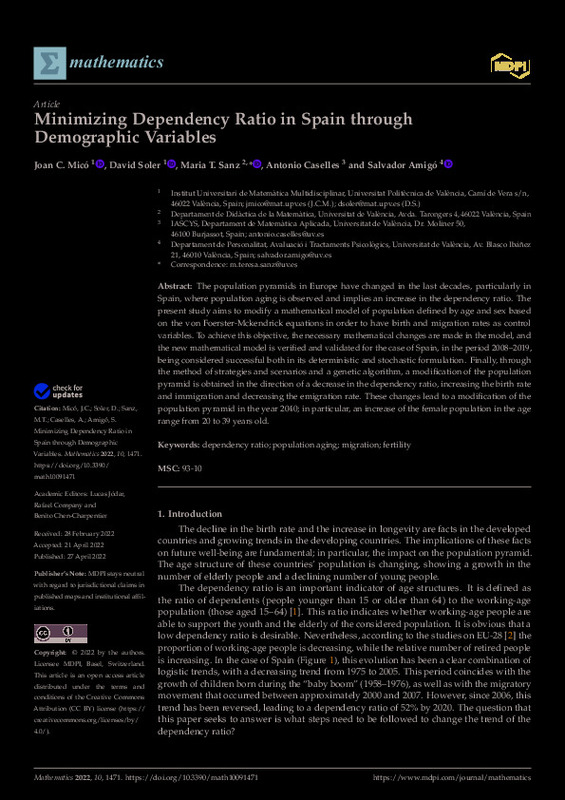JavaScript is disabled for your browser. Some features of this site may not work without it.
Buscar en RiuNet
Listar
Mi cuenta
Estadísticas
Ayuda RiuNet
Admin. UPV
Minimizing Dependency Ratio in Spain through Demographic Variables
Mostrar el registro sencillo del ítem
Ficheros en el ítem
| dc.contributor.author | Micó, Joan C.
|
es_ES |
| dc.contributor.author | Soler Fernández, David
|
es_ES |
| dc.contributor.author | Sanz, María T.
|
es_ES |
| dc.contributor.author | Caselles, Antonio
|
es_ES |
| dc.contributor.author | Amigó, Salvador
|
es_ES |
| dc.date.accessioned | 2023-02-03T19:01:08Z | |
| dc.date.available | 2023-02-03T19:01:08Z | |
| dc.date.issued | 2022-05 | es_ES |
| dc.identifier.uri | http://hdl.handle.net/10251/191621 | |
| dc.description.abstract | [EN] The population pyramids in Europe have changed in the last decades, particularly in Spain, where population aging is observed and implies an increase in the dependency ratio. The present study aims to modify a mathematical model of population defined by age and sex based on the von Foerster-Mckendrick equations in order to have birth and migration rates as control variables. To achieve this objective, the necessary mathematical changes are made in the model, and the new mathematical model is verified and validated for the case of Spain, in the period 2008-2019, being considered successful both in its deterministic and stochastic formulation. Finally, through the method of strategies and scenarios and a genetic algorithm, a modification of the population pyramid is obtained in the direction of a decrease in the dependency ratio, increasing the birth rate and immigration and decreasing the emigration rate. These changes lead to a modification of the population pyramid in the year 2040; in particular, an increase of the female population in the age range from 20 to 39 years old. | es_ES |
| dc.description.sponsorship | This research was partially funded by R&D project RTI2018-096384-B-I00, funded by MCIN/AEI/10.13039/501100011033 and "ERDF A way of making Europe". | es_ES |
| dc.language | Inglés | es_ES |
| dc.publisher | MDPI AG | es_ES |
| dc.relation.ispartof | Mathematics | es_ES |
| dc.rights | Reconocimiento (by) | es_ES |
| dc.subject | Dependency ratio | es_ES |
| dc.subject | Population aging | es_ES |
| dc.subject | Migration | es_ES |
| dc.subject | Fertility | es_ES |
| dc.subject.classification | MATEMATICA APLICADA | es_ES |
| dc.title | Minimizing Dependency Ratio in Spain through Demographic Variables | es_ES |
| dc.type | Artículo | es_ES |
| dc.identifier.doi | 10.3390/math10091471 | es_ES |
| dc.relation.projectID | info:eu-repo/grantAgreement/AEI/Plan Estatal de Investigación Científica y Técnica y de Innovación 2017-2020/RTI2018-096384-B-I00/ES/SOLUCIONES PARA UNA GESTION EFICIENTE DEL TRAFICO VEHICULAR BASADAS EN SISTEMAS Y SERVICIOS EN RED/ | es_ES |
| dc.rights.accessRights | Abierto | es_ES |
| dc.contributor.affiliation | Universitat Politècnica de València. Escuela Técnica Superior de Gestión en la Edificación - Escola Tècnica Superior de Gestió en l'Edificació | es_ES |
| dc.contributor.affiliation | Universitat Politècnica de València. Escuela Técnica Superior de Ingenieros Industriales - Escola Tècnica Superior d'Enginyers Industrials | es_ES |
| dc.description.bibliographicCitation | Micó, JC.; Soler Fernández, D.; Sanz, MT.; Caselles, A.; Amigó, S. (2022). Minimizing Dependency Ratio in Spain through Demographic Variables. Mathematics. 10(9):1-15. https://doi.org/10.3390/math10091471 | es_ES |
| dc.description.accrualMethod | S | es_ES |
| dc.relation.publisherversion | https://doi.org/10.3390/math10091471 | es_ES |
| dc.description.upvformatpinicio | 1 | es_ES |
| dc.description.upvformatpfin | 15 | es_ES |
| dc.type.version | info:eu-repo/semantics/publishedVersion | es_ES |
| dc.description.volume | 10 | es_ES |
| dc.description.issue | 9 | es_ES |
| dc.identifier.eissn | 2227-7390 | es_ES |
| dc.relation.pasarela | S\462831 | es_ES |
| dc.contributor.funder | AGENCIA ESTATAL DE INVESTIGACION | es_ES |
| dc.contributor.funder | European Regional Development Fund | es_ES |
| dc.subject.ods | 08.- Fomentar el crecimiento económico sostenido, inclusivo y sostenible, el empleo pleno y productivo, y el trabajo decente para todos | es_ES |
| upv.costeAPC | 376,42 | es_ES |








